An unforgettable Carnival time
Let me start saying that putting on my brand-new shoes for the first time during the Carnival period has been a colossal mistake. Though I had been wearing them for just a few hours, I spent quite a lot of time in the evening rubbing them with a sponge in order to wash away all the grime they had accumulated. However, I must admit that starting off with such a bitter remark has been a bit unfair towards this unique festivity. Looking at the glass half full, indeed, we may say that the traditional Carnival celebrations in Vilanova i la Geltrù, despite implying a few rather annoying consequences for local people, is something really worth seeing if you happen to be around in February or March.
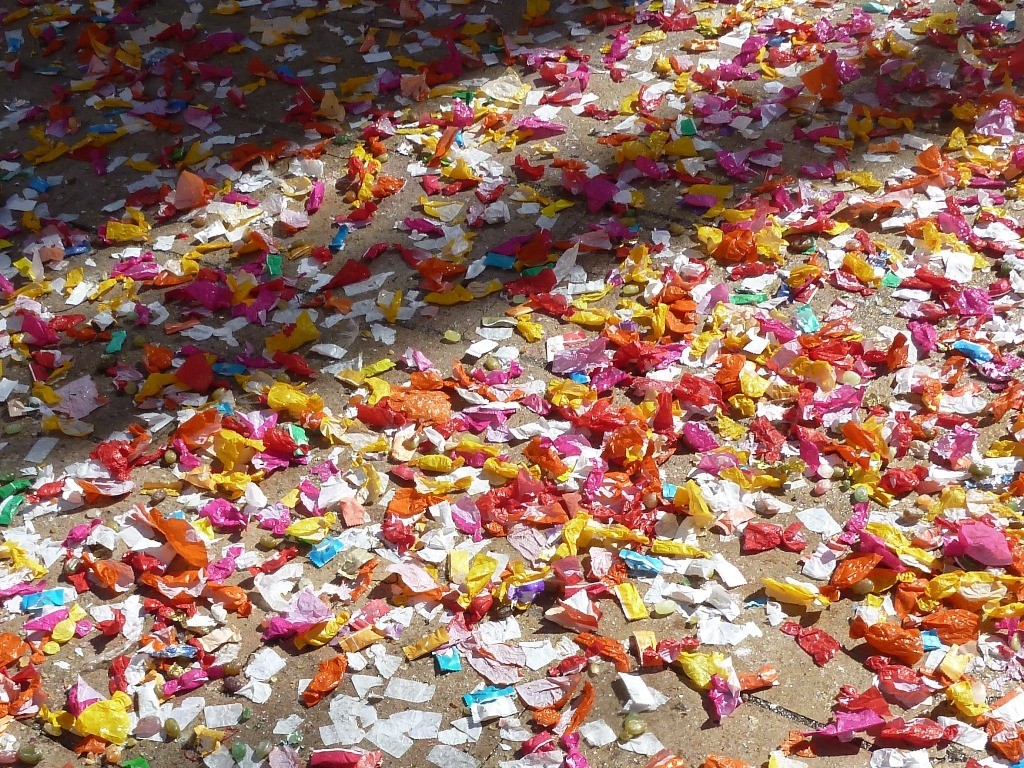
Just to start, let me devote a few lines to the usual historical introduction: you will find I have good reasons to do so. Indeed, it seems that the Carnival of Vilanova i la Geltrù is one of the oldest in the world, boasting a long-lasting tradition of over 2 centuries. Precisely for this reason, it was the only Carnival in Catalonia which survived the ban imposed during the dictatorship of Francisco Franco. Despite changing the name to an apparently neutral "Fiestas de Invierno" (Winter Feast), indeed, the Vilanovins kept celebrating the Carnival in the traditional fashion, though in a somewhat sober way. After the end of the dictatorship, though, the celebrations were restored to the former glory, and gradually grew to the extent that they are now of national interest (the Generalitat de Catalunya has declared the Carnival of Vilanova i la Geltrù "Fiesta Patrimonial de Interés Nacional", "A Traditional Feast of National Interest").
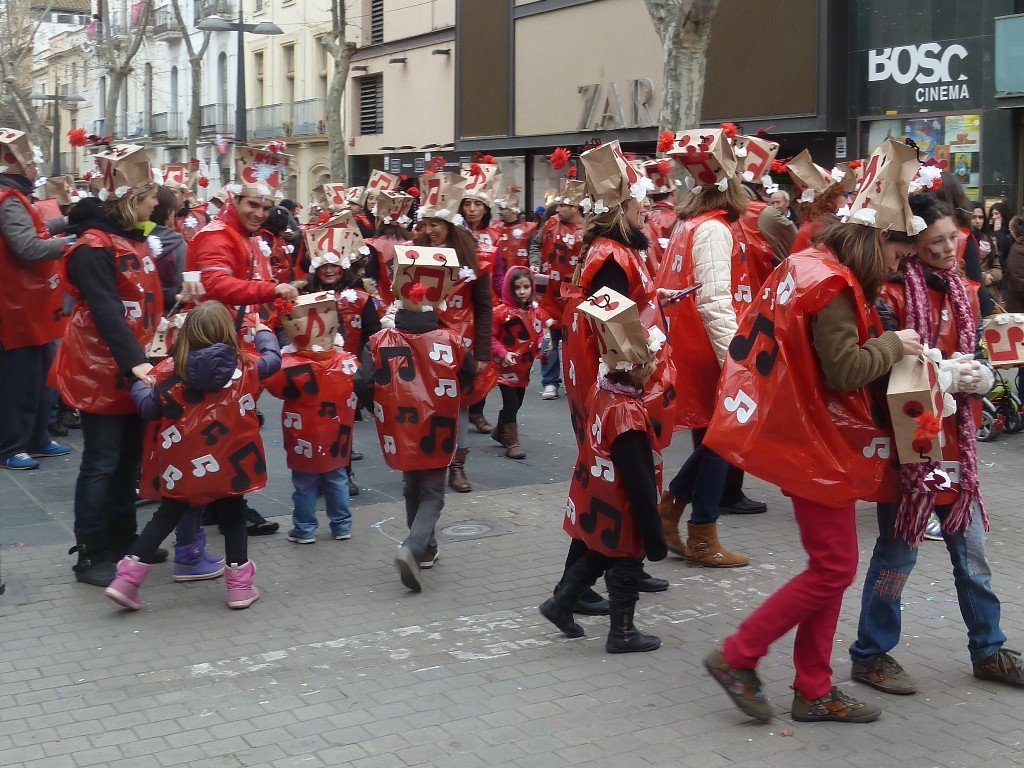
So far, so good. Well, actually not that good for the Carnival of Sitges, which despite a growing fame definitely lacks the historical value of that of Vilanova i la Geltrù. Anyway, be prepared to be witnessing Carnival celebrations for at least a week, if you happen to be in Vilanova. Since Shrove Thursday to Ash Wednesday, indeed, a week of madness will characterise the life of the town with such a vivacity which is not found anywhere else in Catalonia (nor in any other place I have ever seen. To say the truth, the actual beginning of the celebration falls on the 11th day before Ash Wednesday, a day called Dissabte de Mantons in Catalan, meaning "Saturday of Mantons". It is the first occasion in which the couples for the Carnival celebrations go out together, taking part in a masked ball called Ball de Mantons (mantons are special cloaks worn by the women in Carnival time).
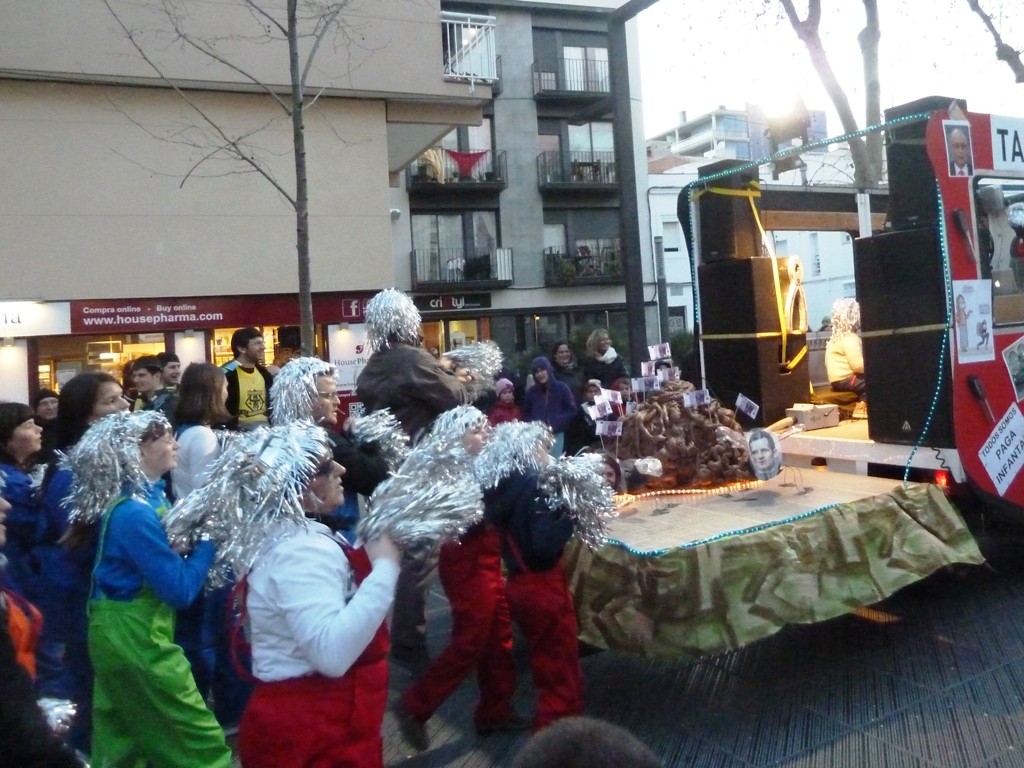
However, the first meaty bit of the Carnival is of course scheduled on Jueves Lardero (Dijous Gras in Catalan, meaning "Shrove Thurdsay"). Children are the great protagonist of the "Merengada", as they pour out into the streets throwing liquid meringue to each other. It has been really funny to see them going around in small groups, dressed in a sort of plastic sack in order to preserve their clothes, hiding from each other or ambushing right behind the corner of a street. Provided you succeed in surviving this joyful battle without any harm, you may make the most of the best part of the Merengada, that is the degustation of this typical dessert! Local people also gather in late evening for a Xatonada, that is a typical meal based on xatò, a local sauce to be poured onto codfish, olives and tortilla).
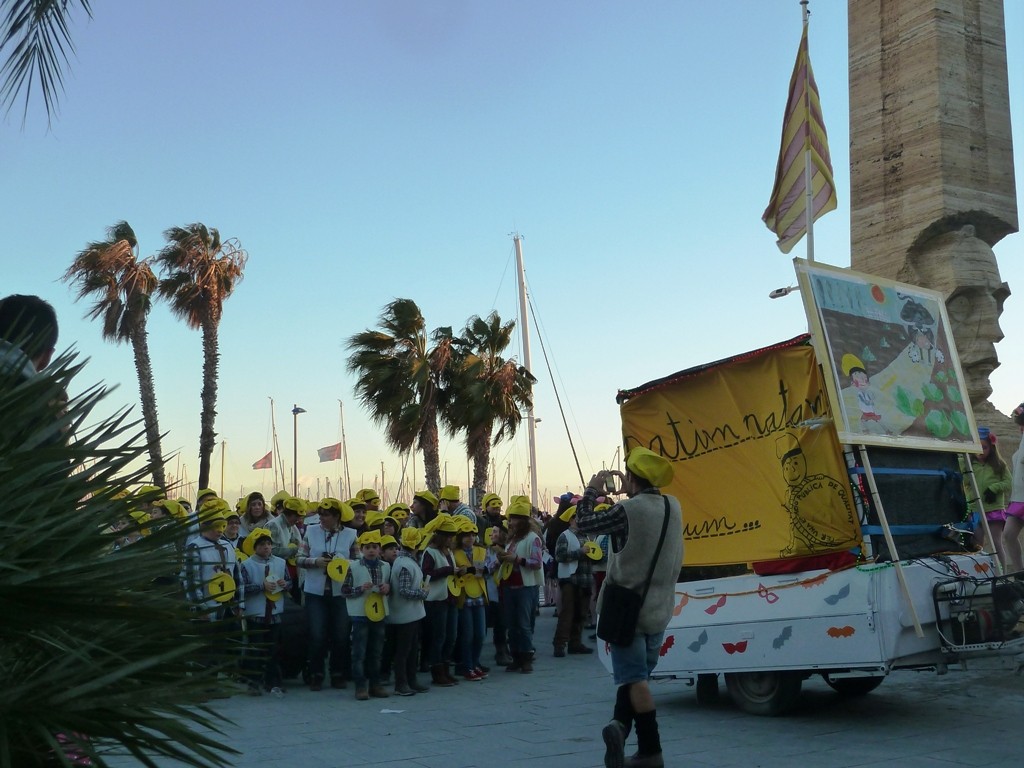
On the following day, another main celebration is held, namely the Llegada del Rey Carnestoltes (the arrival of the king Carnestoltes, which is more or less regarded as the embodiment of the Carnival spirit). It consists in a spectacular parade, starting from the seaside promenade and finally reaching Plaça de la Vila (which by the way is the setting for most of the celebrations, together with the Rambla Principal). Many local people take part in the procession, featuring costumes of various kinds, such as parodies of politicians or some others well-known personalities. King Carnestoltes, who follows the parade in his own coach, finally gives a satiric speech once in Plaça de la Vila. Though maybe a bit long (and perhaps too late in the evening, as it started at dusk), the parade is worth seeing due to the variety of interesting costumes. Nevertheless, I must warn you that you may find the firecrackers and small fireworks, which are fired right from the middle of the parade, a bit annoying.

Then the Sabado de Mascarotas (Dissabte de Mascarots) follows. From now on, it will be impossible to go around without seeing people dressed up everywhere in the streets (and with rather funny and original costumes as well!). Even the people in the local marketplace wear special clothes, as I could see during my grocery shop. Although, the most interesting event of the day is probably the Baile de los Malcasados (Ball de Malcasats, "Ball of the ill-married"), where some couples which discuss their problems, in a satiric fashion, during the dance. Though I could not attend this event, I could anyway witness an interesting parade along the Rambla Principal, featuring various groups of people waving their traditional flag.
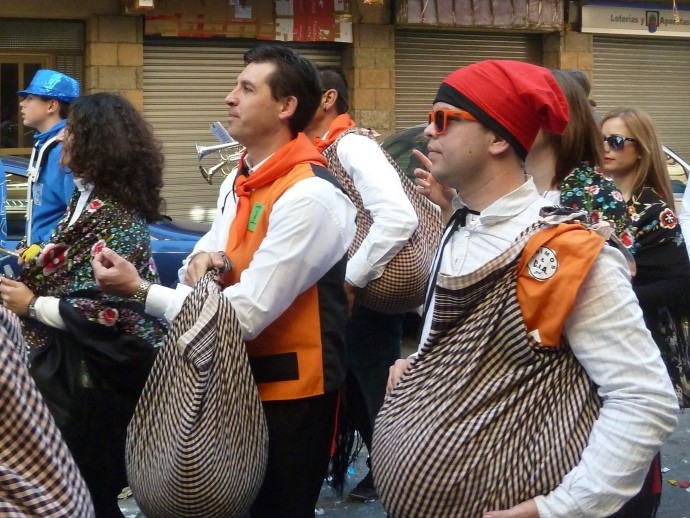
However, the most spectacular (and crazy) day of the whole Carnival is Sunday, called Domingo de Comparsas (Diumenge de Comparses). It is the day when the Vilanovins "salen de comparsa", which means they become the great protagonists of the celebrations. Dressed up in a peculiar and traditional way (the men with a shirt and a sort of apron where they keep the sweets, the woman with a dress and the abovementioned mantons, obviously distinctive of their own district) they pour into the street early in the morning. Of course, forget sleeping until late on this special day: no sooner than 9 o'clock in the morning, indeed, the different groups of comparses walk along the streets of Vilanova i la Geltrù, accompanied by a small orchestra playing suitable music. Apart from showing off their costumes and cheering the atmosphere, the comparses usually throw sweets to the passers-by or to other groups. As a result, by noontime the streets will already be littered with colourful (but above all sticky) sweets.
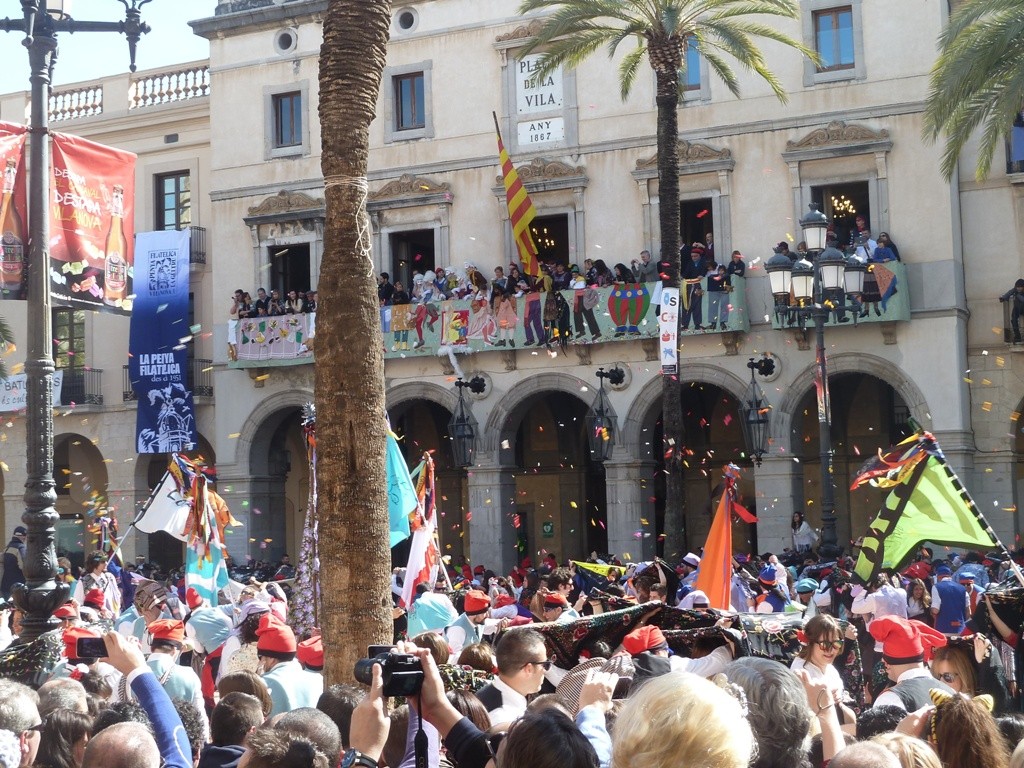
The core of the celebration, though, is yet to come. In late morning, indeed, the groups (and most of the Vilanovins who, not taking part directly, want to enjoy the show) start heading towards the centre, more precisely to Plaça de la Vila, where the famous Guerres dels Caramels (Wars of the Sweets) will take place. It consists in a spectacular battle, held in the middle of the square, featuring two groups of comparses. Before describing this unbelievable event, though, I should tell something about the difficulties we had to go through in order to go and see it. Once in the Rambla Principal, indeed, the crowd became really oppressive, as many tourist and people from the rest of Catalonia had gathered to attend. Therefore, always trying to avoid the sweets which were starting to clutter on the pavements (a task which would soon become too hard), we managed to reach Plaça de la Vila through a secondary street. The crowd in the square was impressive: though the battles had just started (since 12.30 a battle is scheduled every 30 minutes more or less) we could barely find a place, obviously not a first line one, to wait for the next show.
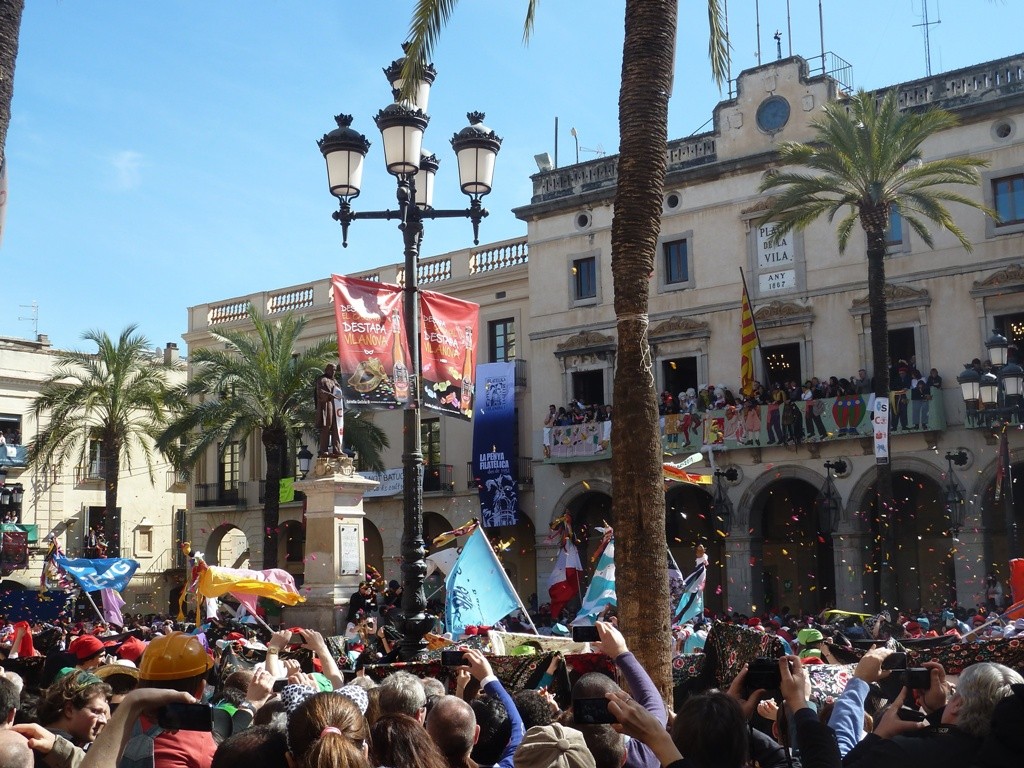
After waiting for what had seemed an endless time (though probably due to the uncomfortable conditions), we could finally catch sight of the comparses. Observing them from close distance before they were introduced into the square, we could notice the huge amount of sweets with the men were carrying in their aprons. Then a sort of short parade, with the two groups waving their flags and cheering the attendance, followed, and...it was time for the battle at last! A deadly silent fell in the square, until the director finally gave the go-ahead. In a few seconds, the whole place went wild, as the air was suddenly full of multicoloured bullets, flying from one side to the other among cries and incitements. The men kept throwing sweets to the other groups while the women were trying and protect them with their mantons for at least 5 minutes, until the signal finally put an end to the battle. Most of the comparses were apparently unharmed, and left the square among the roaring applause of the crowd. Though quite uncomfortably perched on a barrier, I could catch sight of the show from distance, and I must admit it was really worth seeing.
Quite surprisingly, at least to me, the Carnival celebrations did not end at all on Sunday evening. Though I was not able to attend them, indeed, some interesting events took place on the following days. Very funny to see is probably the Ball de Paperets ("Ball of the small pieces of paper"), held on Monday (Dilluns de Carnaval), whose main protagonists are the children, while the adults devote themselves to sing the Coros de Carnestoltes, satirical and irreverent carols to be sung in the street. On the following day (Dimarts de Vidalot, "Shrove Tuesday"), the celebrations on schedule are surprisingly quite reduced, but the Carnival of Vilanova i la Geltrù still has a big surprise in store. On Ash Wednesday (Dimercres de Cendra), indeed, a big event is held to celebrate the end of the Carnival, namely the burial of the king Carnestoltes (Entierro de la Sardina), who after reading his last will is finally burnt in Plaça de la Vila.
Finally, some practical piece of advice for those of you who might happen to attend the Carnival celebrations in Vilanova i la Geltrù. As for the restaurants (at least the most typical ones) take into account that most of them will be closed both on Thursday (due to the traditional xatonada) and on Sunday evening (when they will probably recover from an intense day). It may be possible to get something to eat on Sunday for lunch (basically tapas), though for a proper lunch you had better make a reservation, as most restaurants are usually packed. If you are planning to see the battle on Sunday, you may try and reach Plaça de la Vila quite early in the morning, in order to gain a good first line place. Nevertheless, be prepared to defend it from the crowd and to avoid being hit during the battle! Needless to say, it is a good idea not to dress with your best clothes and, above all, to use some old shoes if you are going to walk in the centre or in the nearby streets on Sunday or in the following days (otherwise you will end up desperately trying to clean them, as in my case). But again, I really think that the various traditional celebrations really deserve to be attended if you happen to be in Catalonia in Carnival time.
Photo gallery
Content available in other languages
- Español: Un carnaval inolvidable
Share your Erasmus Experience in Vilanova I La Geltru!
If you know Vilanova I La Geltru as native, traveler or as exchange student... share your opinion on Vilanova I La Geltru! Rate different characteristics and share your experience.
Add experience →























Comments (0 comments)